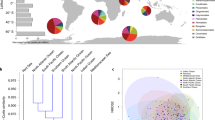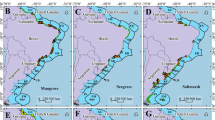Abstract
Vegetated coastal habitats have been identified as important carbon sinks. In contrast to angiosperm-based habitats such as seagrass meadows, salt marshes and mangroves, marine macroalgae have largely been excluded from discussions of marine carbon sinks. Macroalgae are the dominant primary producers in the coastal zone, but they typically do not grow in habitats that are considered to accumulate large stocks of organic carbon. However, the presence of macroalgal carbon in the deep sea and sediments, where it is effectively sequestered from the atmosphere, has been reported. A synthesis of these data suggests that macroalgae could represent an important source of the carbon sequestered in marine sediments and the deep ocean. We propose two main modes for the transport of macroalgae to the deep ocean and sediments: macroalgal material drifting through submarine canyons, and the sinking of negatively buoyant macroalgal detritus. A rough estimate suggests that macroalgae could sequester about 173 TgC yr−1 (with a range of 61–268 TgC yr−1) globally. About 90% of this sequestration occurs through export to the deep sea, and the rest through burial in coastal sediments. This estimate exceeds that for carbon sequestered in angiosperm-based coastal habitats.
This is a preview of subscription content, access via your institution
Access options
Subscribe to this journal
Receive 12 print issues and online access
$259.00 per year
only $21.58 per issue
Buy this article
- Purchase on Springer Link
- Instant access to full article PDF
Prices may be subject to local taxes which are calculated during checkout


KING ABDULLAH UNIVERSITY OF SCIENCE AND TECHNOLOGY

Similar content being viewed by others
References
Duarte, C. M., Middelburg, J. & Caraco, N. Major role of marine vegetation on the oceanic carbon cycle. Biogeosciences 2, 1–8 (2005).
Nellemann, C. et al. Blue Carbon: a Rapid Response Assessment (United Nations Environment Programme, 2009).
Mcleod, E. et al. A blueprint for blue carbon: toward an improved understanding of the role of vegetated coastal habitats in sequestering CO2 . Front. Ecol. Environ. 7, 362–370 (2011).
Duarte, C. M., Losada, I. J. Hendriks, I. E. Mazarrasa I. & Marbà. N. The role of coastal plant communities for climate change mitigation and adaptation. Nat. Clim. Change 3, 961–968 (2013).
Blue Future: coastal wetlands can have a crucial role in the fight against climate change. Nature 529, 255–256 (2016).
Smith, S. V. Marine macrophytes as a global carbon sink. Science 211, 838–840 (1981).
Duarte, C. M. & Cebrián, J. The fate of marine autotrophic production. Limnol. Oceanogr. 41, 1758–1766 (1996).
Hill, R. et al. Can macroalgae contribute to blue carbon? an Australian perspective. Limnol. Oceanogr. 60, 1689–1706 (2015).
Hardison, A. K. et al. Microphytobenthos and benthic macroalgae determine sediment organic matter composition in shallow photic sediments. Biogeosciences 10, 5571–5588 (2013).
Krumhansl, K. A. & Scheibling, R. E. Production and fate of kelp detritus. Mar. Ecol. Prog. Ser. 67, 281–302 (2012).
Filbee-Dexter, K. & Scheibling, R. E. Detrital kelp subsidy supports high reproductive condition of deep-living sea urchins in a sedimentary basin. Aquat. Biol. 23, 71–86 (2014).
Barron, C., Apostolaki, E. T. & Duarte, C. M. Dissolved organic carbon fluxes by seagrass meadows and macroalgal beds. Front. Mar. Sci. 1, 42 (2014).
Barrón, C. & Duarte, C. M. Dissolved organic carbon pools and export from the coastal ocean. Glob. Biogeochem. Cycles 29, 1725–1738 (2015).
Reed, D. C. et al. Patterns and controls of reef-scale production of dissolved organic carbon by giant kelp Macrocystis pyrifera. Limnol. Oceanogr. 60, 1996–2008 (2015).
Sondak, C. F. & Chung, I. K. Potential blue carbon from coastal ecosystems in the Republic of Korea. Ocean Sci. J. 50, 1–8 (2015).
van der Heijden, L. H. & Kamenos, N. A. Reviews and syntheses: calculating the global contribution of coralline algae to carbon burial. Biogeosciences 12, 6429–6441 (2015).
Trevathan-Tackett, S. M. et al. Comparison of marine macrophytes for their contributions to blue carbon sequestration. Ecology 96, 3043–3057 (2015).
Fraser, C. I. in Seaweed Phylogeography (ed. Fraser C. I.) Ch. 5, 131–146 (Springer, 2016).
Macaya, E. C., López, B., Tala, F., Tellier, F. & Thiel, M. in Seaweed Phylogeography (ed. Fraser C. I.) Ch. 4, 97–130 (Springer, 2016).
Garden, C. J. & Smith, A. M. Voyages of seaweeds: The role of macroalgae in sediment transport. Sediment. Geol. 318, 1–9 (2015).
Wolff, T. The systematics and biology of bathyal and abyssal Isopoda Aselotta. Galathea Rep. 6, 1–320 (1962).
Fabry, V. J. & Deuser, W. G. Aragonite and magnesian calcite fluxes to the deep Sargasso Sea. Deep Sea Res. 38, 713–728 (1991).
Han, T. & Runnegar, B. Megascopic eukaryotic algae from the 2.1-billion-year-old Negaunee Iron-Formation, Michigan. Science 257, 232–235 (1992).
Sun, Y., Mao, S., Wang, F., Peng, P. & Chai, P. Identification of the Kukersite-type source rocks in the Ordovician stratigraphy from the Tarim Basin, NW China. Chinese Sci. Bull. 58, 4450–4458 (2013).
Xie, X. et al. Petrology and hydrocarbon potential of microalgal and macroalgal dominated oil shales from the Eocene Huadian Formation, NE China. Int. J. Coal Geol. 124, 36–47 (2014).
Renaud, P. E., Løkken, T. S., Jørgensen, L. L., Berge, J. & Johnson, B. J. Macroalgal detritus and food-web subsidies along an Arctic fjord depth-gradient. Front. Mar. Sci. 2, 31 (2015).
Chikaraishi Y. in Treatise on Geochemistry 5: Organic Geochemistry (eds Birrer, B. et al.) Ch. 12.5, 95–123 (Elsevier, 2014).
De Leo, F. C., Smith, C. R., Rowden, A. A., Bowden, D. A. & Clark, M. R. Submarine canyons: hotspots of benthic biomass and productivity in the deep sea. Proc. R. Soc. B. 277, 2783–2792 (2010).
Canals, M. et al. Flushing submarine canyons. Nature 444, 354–357 (2006).
Harrold, C. & Lisin, S. Radio-tracking rafts of giant kelp: local production and regional transport. J. Exp. Mar. Biol. Ecol. 130, 237–251 (1989).
Palanques, A. et al. Downward particle fluxes and sediment accumulation rates in the western Bransfield Strait: implications of lateral transport for carbon cycle studies in Antarctic marginal seas. J. Mar. Res. 60, 347–365 (2002).
de Bettignies, T. et al. Phenological decoupling of mortality from wave forcing in kelp beds. Ecology 96, 850–861 (2015).
Dierssen, H. M., Zimmerman, R. C., Drake, L. A. & Burdige, D. J. Potential export of unattached benthic macroalgae to the deep sea trough wind-driven Langmuir circulation. Geophys. Res. Lett. 36, L04602 (2009).
Hobday, A. J. Abundance and dispersal of drifting kelp Macrocystis pyrifera rafts in the Southern California Bight. Mar Ecol. Prog. Ser. 195, 101–116 (2000).
Rowe, G. T. & Staresinic, N. Sources of organic matter to the deep-sea benthos. Ambio Special Report 1, 19–23 (1979).
Kingsbury, J. M. Christopher Columbus as a botanist. Arnoldia 52, 11–28 (1992).
Johnson, D. L. & Richardson, P. L. On the wind-induced sinking of Sargassum. J. Exp. Mar. Biol. Ecol. 28, 255–267 (1977).
Harrold, C., Light, K. & Lisin S. Organic enrichment of submarine canyon and continental shelf benthic communities by macroalgal drift imported from nearshore kelp forests. Limnol. Oceanogr. 43, 669–678 (1998).
Bauer, J. E. & Druffel, E. R. Ocean margins as a significant source of organic matter to the deep open ocean. Nature 92, 482–485 (1998).
Josselyn, M. N. et al. Composition, export and faunal utilization of drift vegetation in the Salt River submarine canyon. Estuar. Coast. Shelf Sci. 17, 447–465 (1983).
Hardison, A., Canuel, E. A., Anderson, I. C. & Veuger, B. Fate of macroalgae in benthic systems: carbon and nitrogen cycling within the microbial community. Mar. Ecol. Prog. Ser. 414, 41–55 (2010).
Wernberg, T. et al. Seaweed communities in retreat from ocean warming. Curr. Biol. 21, 1828–1832 (2011).
Smale, D. A., Burrows, M. T., Moore, P., O'Connor, N. & Hawkins, S. J. Threats and knowledge gaps for ecosystem services provided by kelp forests: a northeast Atlantic perspective. Ecol. Evol. 3, 4016–4038 (2013).
Poloczanska, E. S. et al. Global imprint of climate change on marine life. Nat. Clim. Change 3, 919–925 (2013).
Krause-Jensen, D. & Duarte, C. M. Expansion of vegetated coastal ecosystems in the future Arctic. Front. Mar. Sci. 1, 77 (2014).
Krumhansl, K. A., Lauzon-Guay, J. S. & Scheibling, R. E. Modeling effects of climate change and phase shifts on detrital production of a kelp bed. Ecology 95, 763–774 (2014).
Duarte, C. M. Global change and the future ocean: a grand challenge for marine sciences. Front. Mar. Sci. 1, 63 (2014).
Smetacek, V. & Zingone, A. Green and golden seaweed tides on the rise. Nature 504, 84–88 (2013).
Duarte, C. M. et al. Will the oceans help feed humanity? BioScience 59, 967–976 (2009).
Olsen, Y. How can mariculture better help feed humanity? Front. Mar. Sci. 2, 46 (2015).
Gattuso, J. P., Frankignoulle, M. & Wollast, R. Carbon and carbonate metabolism in coastal aquatic ecosystems. Annu. Rev. Ecol. Syst. 29, 405–434 (1998).
Whittaker, R. H. & Likens, G. E. Carbon and the biota. Brookhaven Symp. Biol. 24, 281–302 (1973).
Gattuso, J. P., Gentili, B., Duarte, C. M., Kleypas, J. A., Middelburg, J. J. & Antoine, D. Light availability in the coastal ocean: impact on the distribution of benthic photosynthetic organisms and their contribution to primary production. Biogeosciences 3, 489–513 (2006).
Cebrian, J. & Duarte, C. M. The dependence of herbivory on growth rate in natural plant communities. Funct. Ecol. 4, 518–525 (1994).
Duarte, C. M. Nutrient concentration of aquatic plants: patterns across species. Limnol. Oceanogr. 37, 882–889 (1992).
Charpy-Roubaud, C. & Sournia, A. The comparative estimation of phytoplanktonic, microphytobenthic and macrophytobenthic primary production in the oceans. Mar. Microb. Food Webs 4, 31–57 (1990).
Baines, S. B. & Pace, M. L. The production of dissolved organic matter by phytoplankton and its importance to bacteria: patterns across marine and freshwater systems. Limnol. Oceanogr. 36, 1078–1090 (1991).
Ciais, P. et al. in Climate Change 2013: The Physical Science Basis (eds Stocker, T. F. et al.) Ch. 6, 465–570 (IPCC, Cambridge Univ. Press, 2013).
Hardison, A., Canuel, E. A., Anderson, I. C. & Veuger, B. Fate of macroalgae in benthic systems: carbon and nitrogen cycling within the microbial community. Mar. Ecol. Prog. Ser. 414, 41–55 (2010).
Acknowledgements
The study was funded by the COCOA project under the BONUS programme, which is funded by the EU 7th Framework Programme, the Danish Research Council and KAUST. We thank I. Gromicho (KAUST) for the artwork in Fig. 2 and A. Kjeldgaard and T. Christensen for help with Fig. 1. The study is also a contribution to the Greenland Ecosystem Monitoring programme (www.G-E-M.dk) and the Arctic Science Partnership (www.asp-net.org).
Author information
Authors and Affiliations
Corresponding author
Ethics declarations
Competing interests
The authors declare no competing financial interests.
Supplementary information
Supplementary information
Supplementary information (PDF 215 kb)
Rights and permissions
About this article
Cite this article
Krause-Jensen, D., Duarte, C. Substantial role of macroalgae in marine carbon sequestration. Nature Geosci 9, 737–742 (2016). https://doi.org/10.1038/ngeo2790
Received:
Accepted:
Published:
Issue Date:
DOI: https://doi.org/10.1038/ngeo2790
This article is cited by
-
Substantial kelp detritus exported beyond the continental shelf by dense shelf water transport
Scientific Reports (2024)
-
Giant kelp (Macrocystis pyrifera) morphological and reproductive strategies in two contrasting sub-Antarctic forests
Marine Biology (2024)
-
Uncovering the world’s largest carbon sink—a profile of ocean carbon sinks research
Environmental Science and Pollution Research (2024)
-
Life cycle assessment of a marine biorefinery producing protein, bioactives and polymeric packaging material
The International Journal of Life Cycle Assessment (2024)
-
Epiphytic common core bacteria in the microbiomes of co-located green (Ulva), brown (Saccharina) and red (Grateloupia, Gelidium) macroalgae
Microbiome (2023)



